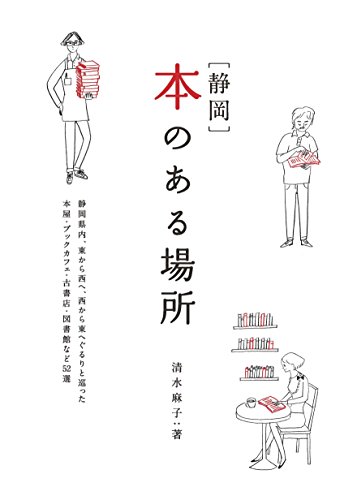1 0 0 0 IR 混住地域における来住者の部落問題に対する意識と態度
- 著者
- 上田 一雄
- 出版者
- 大阪市立大学
- 雑誌
- 同和問題研究 : 大阪市立大学同和問題研究室紀要 (ISSN:03860973)
- 巻号頁・発行日
- vol.4, pp.1-21, 1980-03
1 0 0 0 「静岡」本のある場所
- 著者
- 清水麻子著
- 出版者
- インプレス (発売)
- 巻号頁・発行日
- 2014
1 0 0 0 新米館長のアンテナ
- 著者
- 恩田征弥著
- 出版者
- 静岡教育出版社 (製作), 2004.3
- 巻号頁・発行日
- 2004
1 0 0 0 輝く静岡の先人
- 著者
- 静岡県県民部文化学術局文化政策室編集
- 出版者
- 静岡県
- 巻号頁・発行日
- 2009
- 著者
- 岡本真+LRG編集部 [編] . 猪谷千香 [著] . 嶋田学 [著] . 小林隆志 [述] . 高橋真太郎 [著]
- 出版者
- アカデミック・リソース・ガイド
- 巻号頁・発行日
- 2016
- 著者
- 渡辺 勝
- 出版者
- 日本図書館協会
- 雑誌
- 図書館雑誌 (ISSN:03854000)
- 巻号頁・発行日
- vol.107, no.11, pp.698-699, 2013-11
- 著者
- 土屋 雅彦
- 出版者
- 日本図書館協会
- 雑誌
- 図書館雑誌 (ISSN:03854000)
- 巻号頁・発行日
- vol.101, no.11, pp.752-753, 2007-11
- 著者
- 草谷 桂子
- 出版者
- 図書館問題研究会
- 雑誌
- みんなの図書館 (ISSN:03860914)
- 巻号頁・発行日
- no.314, pp.31-35, 2003-06
1 0 0 0 IR 静岡県立葵文庫とその事業 : アーカイブズの観点から
- 著者
- 青木 祐一
- 出版者
- 学習院大学
- 雑誌
- 研究年報 (ISSN:04331117)
- 巻号頁・発行日
- vol.59, pp.99-117, 2012
- 著者
- 鈴木 善彦
- 出版者
- 日本図書館協会
- 雑誌
- 図書館雑誌 (ISSN:03854000)
- 巻号頁・発行日
- vol.95, no.8, pp.558-560, 2001-08
- 出版者
- 日経BP社
- 雑誌
- 日経コンピュ-タ (ISSN:02854619)
- 巻号頁・発行日
- no.453, pp.201-203, 1998-09-28
「なぜ2000年問題の対策のために,今まで利用してきたパッケージをバージョンアップしなければならないのか」。今年7月11日,西暦2000年問題の対策のために商店街が運営する「パルムポイントカード」のシステムを再構築した武蔵小山商店街振興組合(東京都品川区)の横尾正美販売促進課長は,今でも納得がいかない様子だ。
1 0 0 0 OA 金属の単離の歴史とエネルギー変化および酸化還元電位
- 著者
- 峰岸 常之
- 出版者
- 公益社団法人 日本化学会
- 雑誌
- 化学教育 (ISSN:24326542)
- 巻号頁・発行日
- vol.29, no.6, pp.428-432, 1981-12-20 (Released:2017-09-15)
1 0 0 0 OA 天台圓宗四教五時西谷名目 2巻
- 出版者
- [出版者不明]
- 巻号頁・発行日
- 1600
四教(経典を教理内容から四分類したもの)、五時(経典を釈尊の説法の順序により五分類したもの)等、天台宗学の教義について、初学者に理解させるための解説書。著者、著作年代は未詳だが、比叡山東塔西谷居住の僧侶の著述か。栗色古表紙の左上に題簽の痕跡が一部のみ残る。欄外に墨・朱の書き入れが多い。本文には朱引き、訓点、書き入れがある。全体に紙の疲れが目立つ。見返しに「東来堂常清軒是信斎都融」の墨書。第1丁に「明慶寺」墨書。巻上末に「能美嶌妙覚本」墨書、黒印「覚」。巻下巻頭右下に黒印「居」。巻尾に「明和乙卯十月九日/六十一歳/上下八十一紙」朱書、「釈恵暁」の墨書がある。大東急記念文庫所蔵の久原文庫本とは別版で同版は他に未見。久原文庫本の誤字脱字が修正され、活字はかなり磨滅し印刷面が不明瞭なので、あらたに再版されたものか。
1 0 0 0 IR Lower-Bound on Blocking Probability of a Class of Crosstalk-Free Optical Cross-Connects (OXCs)
- 著者
- YU Chen JIANG Xiaohong HORIGUCHI Susumu
- 出版者
- 一般社団法人電子情報通信学会
- 雑誌
- IEICE transactions on information and systems (ISSN:09168532)
- 巻号頁・発行日
- vol.89, no.2, pp.719-727, 2006-02-01
- 参考文献数
- 22
A combination of horizontal expansion and vertical stacking of optical Banyan (HVOB) is the general architecture for building Banyan-based optical cross-connects (OXCs), and the intrinsic crosstalk problem of optical signals is a major constraint in designing OXCs. In this paper, we analyze the blocking behavior of HVOB networks and develop the lower bound on blocking probability of a HVOB network that is free of first-order crosstalk in switching elements. The proposed lower-bound is significant because it provides network designers an effective tool to estimate the minimum blocking probability they can expect from a HVOB architecture regardless what kind of routing strategy to be adopted. Our lower bound can accurately depict the overall blocking behavior in terms of the minimum blocking probability in a HVOB network, as verified by extensive simulation based on a network simulator with both random routing and packing routing strategies. Surprisingly, the simulated and theoretical results show that our lower bound can be used to efficiently estimate the blocking probability of HVOB networks applying packing strategy. Thus, our analytical model can guide network designers to find the tradeoff among the number of planes (stacked copies), the number of SEs, the number of stages and blocking probability in a HVOB network applying packing strategy.
1 0 0 0 IR 日本語の障害者表現とそのイメージについて : 『国語辞典』と『英和辞典』のあいだ
- 著者
- 生瀬 克己 Katsumi NAMASE 桃山学院大学文学部
- 雑誌
- 国際文化論集 = INTERCULTURAL STUDIES (ISSN:09170219)
- 巻号頁・発行日
- no.6, pp.17-53, 1992-07-20
There are many Japanese words to denote disability and the disabled. Each person has different interpretations of each word. And there are some terms that the disabled and their families find disagreeable. They prefer to be called "shougaisha (inpediment)"; whereas people don't call them so. Why so? This is the subject that I will argue about in this article. The English word, "deformation" or "malformation," is translated as "kikei" which implies "defectiveness," and in turn corresponds to "fugu." And "teratism" and "monstrosity" are translated as "katawa", which implies a "bogy" or a "monster." They are not "human beings"; and so the disabled and their families dislike these Japanese words. My guess is as follows. When the English word "disabled" or "disability" is tanslatet into Japanese, it is translated as "fugu" in many cases. It is very unlikely, however, that in Japanese, we can identify corresponding translations to "inability to do something," and the detailed investigation of translations of the English word "disability" will enable us to claim that we attribute it to Iinguistic characteristics of Japanese.
- 著者
- 松田 裕之
- 出版者
- 日本生態学会
- 雑誌
- 保全生態学研究 (ISSN:13424327)
- 巻号頁・発行日
- vol.9, no.2, pp.209-210, 2004-12-25


